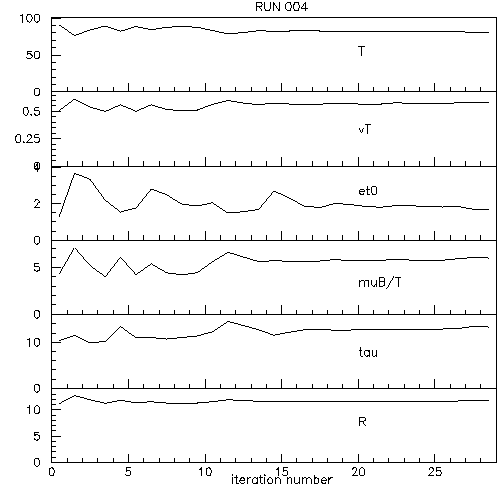
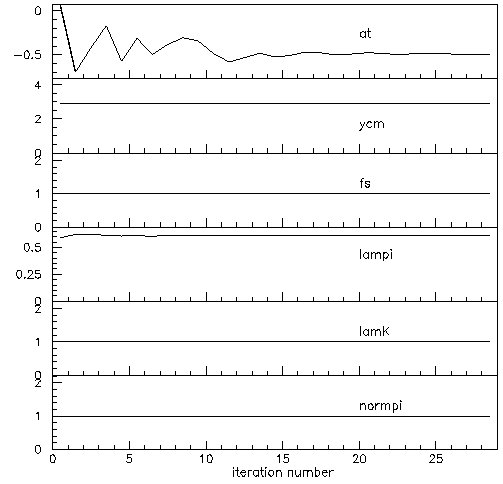
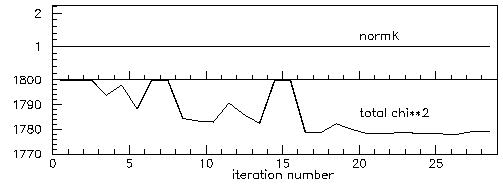
| Go to: |
run 2 run 3 run 4 run 5 run 6 run 7 run 8 run 9 run 10 run 11 pp at 45 GeV Ecm run 12 pp at 53 GeV Ecm run 13 run 14 Bernd EOS #?? run 15 Bernd EOS #?? | (these runs are further down on this page) |
Total chi^2 = 2200.0832258958
chi^2/d.o.f = 1.09022954702468
Probability of perfect model = 2.598157455984717E-03
Fixed parameters:
ycm = 2.9172000
fs = 1.0000000
lamK = 1.0000000
normpi= 1.0000000
normK = 1.0000000
Variable parameters:
T = 89.1540624 +/- 10.7406417 MeV
vT/c = .5240703 +/- .0865532
et0 = 1.8758707 +/- 1.1032839
muB/T = 4.7511487 +/- 2.2679720
tau = 10.0228409 +/- 3.9937278 fm/c
R = 11.0210157 +/- 1.4928521 fm
aT = -.0735064 +/- .7969878
lam = .5863280 +/- .0672217
Calculated Quantities:
vs/c = .9941667 + .0000000 .0000000
vL/c = .9541234 + .0407214 -.3056923
muB = 423.5842038 + 126.5036827 -169.6470697 MeV
t1 = 9.6474389 + 3.3384087 -5.1099395 fm/c
t3 = 33.4748901 + 48.9494066 -18.3320313 fm/c
WARNING: ITMAX exceeded in amoeba2
t2-t1 = .3754020 + 6.5796591 -.3754020 fm/c
dtau = 1.8063586 + 6.3044594 -2.8894995 fm/c
z3 = 31.9391754 + 50.2665640 -21.6622066 fm
muS = 29.1389252 + 28.1835668 -19.4548498 MeV
muI = -2.4691639 + 1.6553135 -3.0460694 MeV
Bar# = 41.7205250 + 78.8954651 -30.4463398
Bproj = 20.8602625 + 39.4477326 -15.2231699
Btarg = 20.8602625 + 39.4477326 -15.2231699
brdn1 = .00425755 + .01220816 -.00275563 fm^-3
brdn2 = .00410803 + .00398629 -.00238532 fm^-3
Total chi^2 = 1778.073427064439
chi^2/d.o.f = .8763299295536912
Probability of perfect model = .9999796677857402
Fixed parameters:
ycm = 2.9172000
fs = 1.0000000
lamK = 1.0000000
normpi= 1.0000000
normK = 1.0000000
Variable parameters:
T = 81.3517317 +/- 13.2606103 MeV
vT/c = .5776417 +/- .1472971
et0 = 1.8441346 +/- .9923328
muB/T = 5.8959335 +/- 3.2235066
tau = 12.9461980 +/- 5.1585422 fm/c
R = 11.6609599 +/- 1.6625828 fm
aT = -.4986597 +/- .4696453
lam = .6128164 +/- .0801392
Calculated Quantities:
vs/c = .9941667 + .0000000 .0000000
vL/c = .9511905 + .0419576 -.2591809
muB = 479.6443980 + 165.7723018 -225.9897493 MeV
t1 = 9.1666055 + 3.7594605 -6.3358354 fm/c
t3 = 41.9507808 + 47.1630627 -20.5271649 fm/c
t2-t1 = 3.7795925 + 9.6003720 -3.6354408 fm/c
dtau = 5.4635857 + 8.6866282 -4.1200523 fm/c
z3 = 39.9031824 + 48.3636862 -24.5207586 fm
muS = 35.3403362 + 52.3112151 -28.6719180 MeV
muI = -2.9005101 + 2.4075098 -7.1196337 MeV
Bar# = 55.3053770 + 213.8606077 -45.9158301
Bproj = 27.6526885 + 106.9303039 -22.9579151
Btarg = 27.6526885 + 106.9303039 -22.9579151
brdn1 = .00536662 + .03108358 -.00444265 fm^-3
brdn2 = .00369691 + .01285448 -.00294275 fm^-3
Here is the evolution of the parameters versus iteration:



**********************************************
Total chi^2 = 2650.344467409264
chi^2/d.o.f = 1.30623187156691
Probability of perfect model = 2.427970617562861E-19
Fixed parameters:
ycm = 2.9172000
fs = 1.0000000
lamK = 1.0000000
normpi= 1.0000000
normK = 1.0000000
Variable parameters:
T = 88.0749915 +/- 12.5109352 MeV
vT/c = .5587841 +/- .0994960
et0 = 1.8697950 +/- 1.0471382
muB/T = 4.3642801 +/- 3.0582565
tau = 9.8342649 +/- 4.3294705 fm/c
R = 11.0914631 +/- 1.6310453 fm
aT = .0410438 +/- .8819925
lam = .5727065 +/- .0671431
Calculated Quantities:
vs/c = .9941667 + .0000000 .0000000
vL/c = .9535755 + .0405881 -.2770622
muB = 384.3839341 + 180.5316795 -244.0191154 MeV
t1 = 10.0340531 + 3.2453745 -3.0651924 fm/c
t3 = 32.6552751 + 39.9427521 -16.6392593 fm/c
WARNING: ITMAX exceeded in amoeba2
t2-t1 = .1997883 + 2.7128800 -.1997883 fm/c
dtau = 1.5128926 + 7.5622605 -2.8536092 fm/c
z3 = 31.1392714 + 40.9332066 -19.7911830 fm
muS = 20.0836201 + 38.1775792 -16.9462500 MeV
muI = -1.5760678 + 1.3189215 -4.0126494 MeV
Bar# = 24.5161148 + 82.1133405 -20.8646577
Bproj = 12.2580574 + 41.0566703 -10.4323289
Btarg = 12.2580574 + 41.0566703 -10.4323289
brdn1 = .00236400 + .01107492 -.00190462 fm^-3
brdn2 = .00241207 + .00493278 -.00186722 fm^-3
Here is the evolution of the parameters versus iteration:
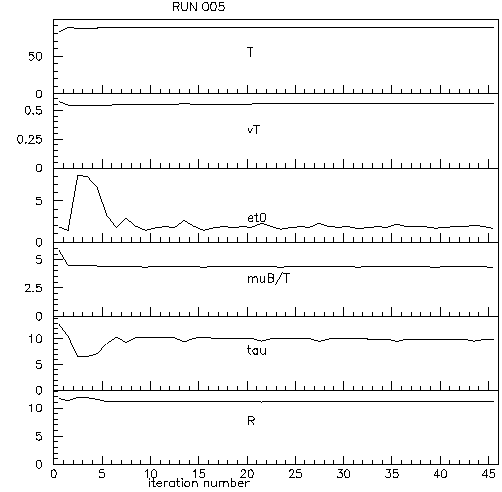
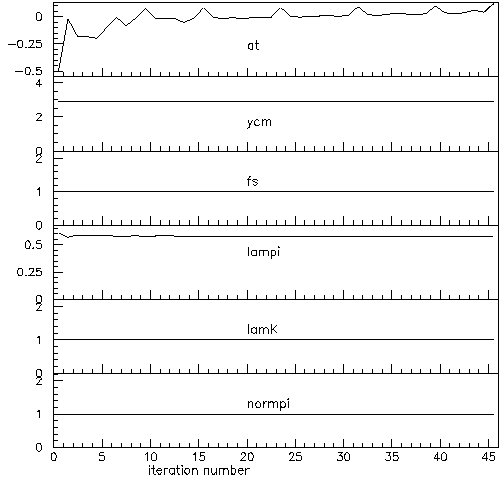
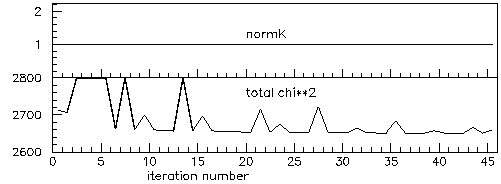
Several technical issues concerning runs 2-5 were fixed.
**********************************************
Total chi^2 = 2068.570225832924
chi^2/d.o.f = 1.01950232914388
Probability of perfect model = .2651235498083625
Fixed parameters:
ycm = 2.9172000
fs = 1.0000000
lamK = 1.0000000
normpi= 1.0000000
normK = 1.0000000
Variable parameters:
T = 109.2261733 +/- 11.3869531 MeV
vT/c = .5465674 +/- .0842201
et0 = 4.9536218 +/- 1.0296980
muB/T = 1.8192319 +/- 3.2280879
tau = 10.0693106 +/- 2.7229680 fm/c
R = 10.2318757 +/- 1.4095665 fm
aT = -.7203386 +/- .3193283
lam = .6810124 +/- .0688779
Now for some comments...
Here is the BEST point !
**********************************************
Total chi^2 = 2484.475403123262
chi^2/d.o.f = 1.06859157123581
Probability of perfect model = 1.081068643462903E-02
Fixed parameters:
ycm = 2.9172000
fs = 1.0000000
lamK = 1.0000000
normpi= 1.0000000
normK = 1.0000000
Variable parameters:
T = 97.4976145 +/- 3.6718998 MeV
vT/c = .6449587 +/- .0381822
et0 = 2.8558611 +/- 2.1728179
muB/T = 4.4271434 +/- .3132801
tau = 11.0626106 +/- 1.9794305 fm/c
R = 12.2124798 +/- 1.4931973 fm
aT = -.4144854 +/- .4356278
lam = .7009970 +/- .0755928
Here is the evolution of the parameters versus iteration:
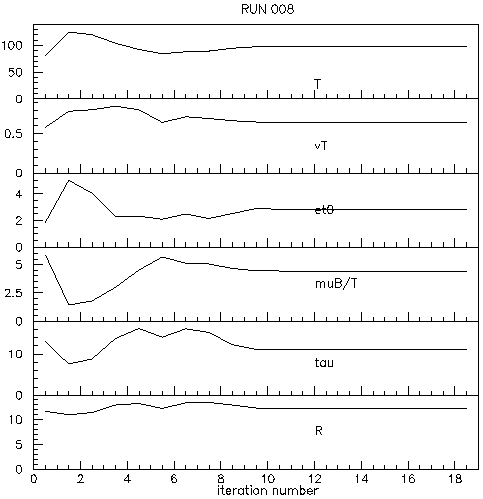

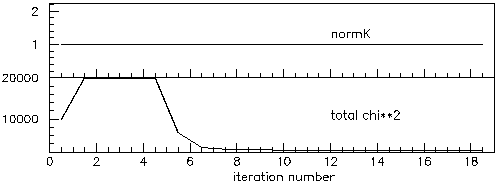
Here is the input parameter file.
This is the complete log file, with the best
point shown here:
Here is the BEST point !
**********************************************
Total chi^2 = 4059.590121781665
chi^2/d.o.f = 1.82617639306418
Probability of perfect model = 1.132583283762988E-110
Fixed parameters:
ycm = 2.9133600
fs = 1.0000000
lamK = 1.0000000
normpi= 1.0000000
normK = 1.0000000
Variable parameters:
T = 107.7725581 +/- 4.7494066 MeV
vT/c = .6874242 +/- .0411258
et0 = 1.3591735 +/- .4035332
muB/T = 7.0364416 +/- .2907355
tau = 13.7627251 +/- 3.1079351 fm/c
R = 13.8736359 +/- 1.7969432 fm
aT = -.2121673 +/- .4051455
lam = .7328811 +/- .0941394
It turns out that due to the two different behaviors of the '1P' edit descriptor in the output format, the cross sections were a factor 10 too large. ignore this run
Here is the complete log file, and this is the best
point from run 10:
Here is the BEST point !
**********************************************
Total chi^2 = 2399.745783828456
chi^2/d.o.f = 1.07950777500156
Probability of perfect model = 4.750309113636794E-03
Fixed parameters:
ycm = 2.9133600
fs = 1.0000000
lamK = 1.0000000
normpi= 1.0000000
normK = 1.0000000
Variable parameters:
T = 97.6856778 +/- 3.6240752 MeV
vT/c = .6422318 +/- .0388430
et0 = 3.0274715 +/- 2.3138305
muB/T = 4.4120854 +/- .3072589
tau = 11.0238382 +/- 1.9513367 fm/c
R = 12.1437446 +/- 1.4855841 fm
aT = -.4392822 +/- .4210797
lam = .7013181 +/- .0760765
Using this plotfrz input file, I got the following
plots:
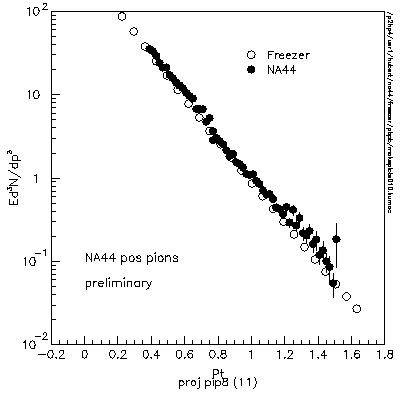 pi+ postscript
pi+ postscript  K+ postscript
K+ postscript 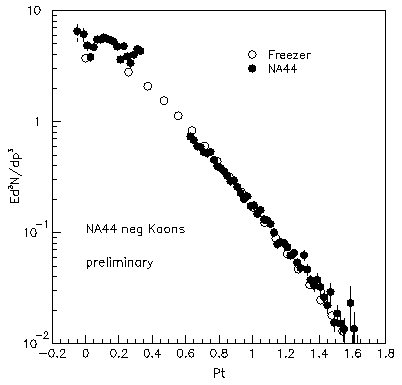 K- postscript
K- postscript
Here is the complete log file, and this is the best
point from run 13:
Here is the BEST point !
**********************************************
Total chi^2 = 2167.08898864524
chi^2/d.o.f = 1.01789055361449
Probability of perfect model = .2774391964874108
Fixed parameters:
ycm = 2.9133600
fs = 1.0000000
lamK = 1.0000000
normpi= 1.0000000
normK = 1.0000000
Variable parameters:
T = 95.3957799 +/- 3.5266607 MeV
vT/c = .6555016 +/- .0363092
et0 = 3.8797202 +/- .8504497
muB/T = 4.7139807 +/- .3286298
tau = 12.5687384 +/- 2.2252282 fm/c
R = 11.4079766 +/- 1.4089314 fm
aT = -.7041592 +/- .2596383
lam = .7006332 +/- .0737855
Calculated Quantities:
vs/c = .9941219 + .0000000 .0000000
vL/c = .9991470 + .0006973 -.0038117
muB = 449.6938666 + 20.4284325 -20.8615881 MeV
t1 = 6.8362936 + 2.3717766 -4.2643491 fm/c
t3 = 304.3603217 + 452.9399985 -182.4860763 fm/c
t2-t1 = 5.7324447 + 5.3741337 -2.8406328 fm/c
dtau = 7.4060118 + 4.3524071 -2.4488403 fm/c
z3 = 304.1006942 + 453.0785602 -182.8508367 fm
muS = 42.4901925 + 5.9045185 -5.4682577 MeV
muI = -4.1057459 + .6612199 -.7397983 MeV
Bar# = 283.7074138 + 91.5093593 -75.4319978
Bproj = 141.8537069 + 45.7546796 -37.7159989
Btarg = 141.8537069 + 45.7546796 -37.7159989
brdn1 = .01785744 + .03120322 -.00665947 fm^-3
brdn2 = .00922878 + .00286935 -.00229689 fm^-3
Using this plotfrz input file, I got the following
plots:
 pi+ postscript
pi+ postscript 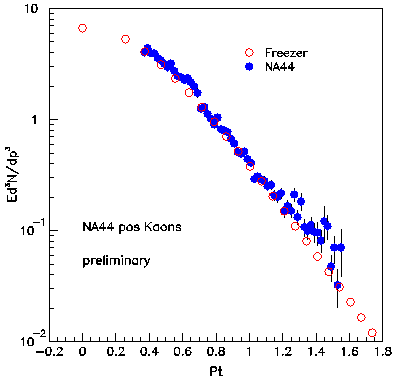 K+ postscript
K+ postscript  K- postscript
K- postscript (I'm now working on trying to display the correlation functions)
 postscript version
postscript version